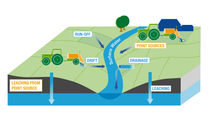Agriculture
Protecting water quality
Water quality can be impacted by point pollution and diffuse pollution caused by fertilizers and crop protection products. How do we ensure that agriculture does not put water quality at risk?
Typically, 50 to 90 percent of pesticide pollution in ground and surface water comes from point pollution sources in agriculture - for example, spillages, incorrect cleaning of spraying equipment or illegal disposal of leftover spray solutions.
These incidents can be avoided by following Good Agricultural Practices.
Diffuse water pollution through pesticides occurs either due to spray drift, surface runoff, drainage losses or leaching to groundwater. When good farming practices are followed, significant pollution incidents are very rare, and risks can be further reduced by adapting the application of crop protection products in vulnerable areas (e.g. karstic areas) as well as through appropriate risk reduction measures, such as establishing vegetated buffer strip alongside surface water bodies.
Potential pollution pathways for pesticides in agricultural landscapes that need to be avoided
We support the correct use of crop protection products as a key element of water protection

The key element for the protection of water is the correct use of crop protection products. Many companies, farmers' an farmers associations, governments, authorities and agricultural advisors initiate and support training programs, such as The Voluntary Initiative in the UK or Pesticide Environmental Stewardship in the US.
The initiative TOPPS Water Protection, established by CropLife Europe, develops practical risk diagnosis concepts for catchments and best management practices for water protection. Various demonstrations in catchments across Europe will show how water protection concepts can be successfully implemented to achieve good water quality in agricultural landscapes.
As a company, BASF continues to inform and train farmers on general best management practices for water protection by providing information and training material to advisors and farmers. In addition to general water protection measures, BASF defines and promotes specific use requirements for relevant products, such as reduced maximum application rates or use restrictions in vulnerable areas.
